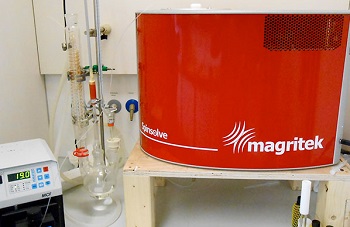Magritek, a leading worldwide provider of compact NMR and MRI instruments, have demonstrated the use of their Spinsolve benchtop NMR spectrometer to perform and monitor chemical reactions on-line.
As costs for energy and raw materials continue to rise, it becomes more critical for chemists to be able to mimic a reaction or to quantify the parameters required to produce a final product without the difficulty and expense of using production facilities. To be able to recreate a production process on a lab bench is therefore highly desirable for many chemists.

The Magritek Spinsolve high-resolution benchtop NMR spectrometer is a device that suits these demands and can be installed directly in a fume hood of a chemistry lab to monitor the progress of chemical reactions on-line. Reactants can be pumped in continuous mode from the reactor to the magnet and back using standard PTFE tubing.
The reaction itself can be carried out at temperatures of up to about 100 °C. When the reaction mixture is pumped through the bore of the magnet using 2 mm o. d. PTFE tubing, it naturally cools down to 30 °C or lower as it flows along the length of the tubing at room temperature. For reactions where maintaining the elevated temperature is critical, Magritek has put together a simple but effective flow set-up for on-line monitoring.
It comprises a Dewar of 5 mm o. d. and 2.25 mm i. d. that is mount¬ed in the bore of the Spinsolve to minimise any heat transfer from the flowing sample to the magnet. The pump, which can be set to operate in continuous or stop-flow mode to acquire points with a time resolution of about 15 seconds, is placed in the flow-loop after the magnet in order to minimise the tubing length that goes from the reactor to the sensitive volume of the Spinsolve.
This approach to reaction monitoring has been demonstrated on a number of classical chemical reactions. For example, acetalisation is a common reaction in organic synthesis where an acetal is produced from an aldehyde and an alcohol. In the example here, acetaldehyde reacts with methanol to produce acetaldehyde dimethyl acetal.
The reaction was performed in DMSO to prevent evaporation. With data being collected every fifteen seconds over a total period of one hour, the user could follow waterfall plots to show the decrease of acetaldehyde as it was used up together with the corresponding rise of the acetaldehyde dimethyl acetal.
These and many other reaction systems are described in the growing library of applications notes and case studies which are freely available for downloading from the Magritek web site where you can also obtain full details of the Spinsolve benchtop NMR spectrometer and the full range of analytical products from Magritek, visit their website.